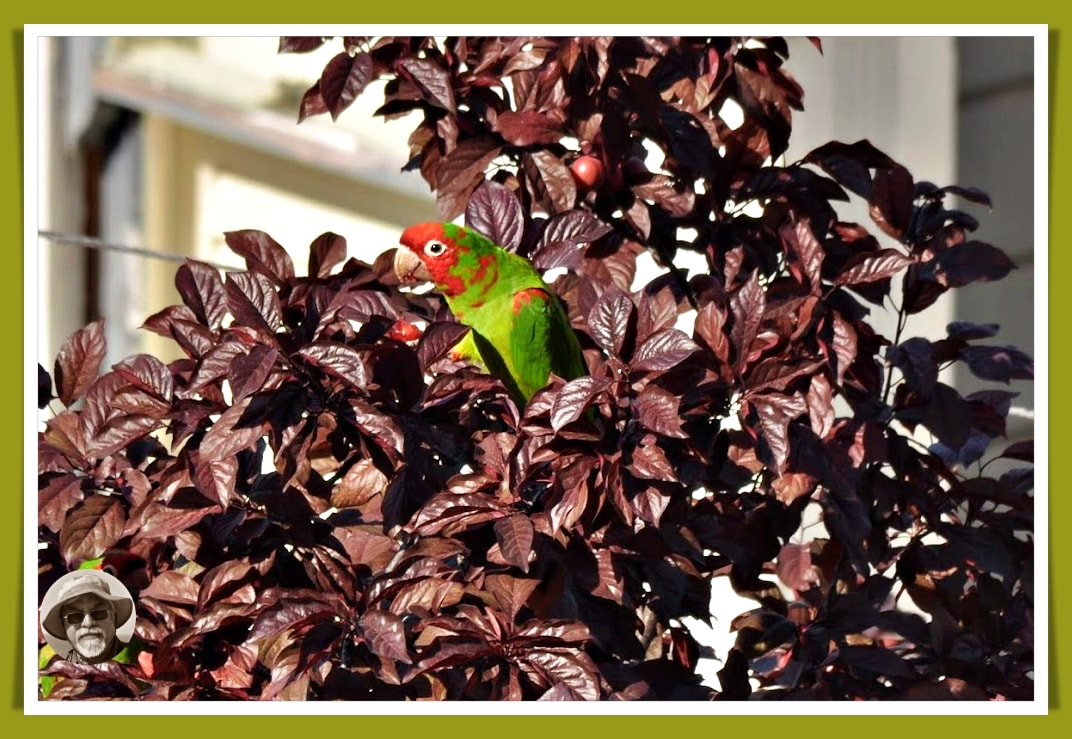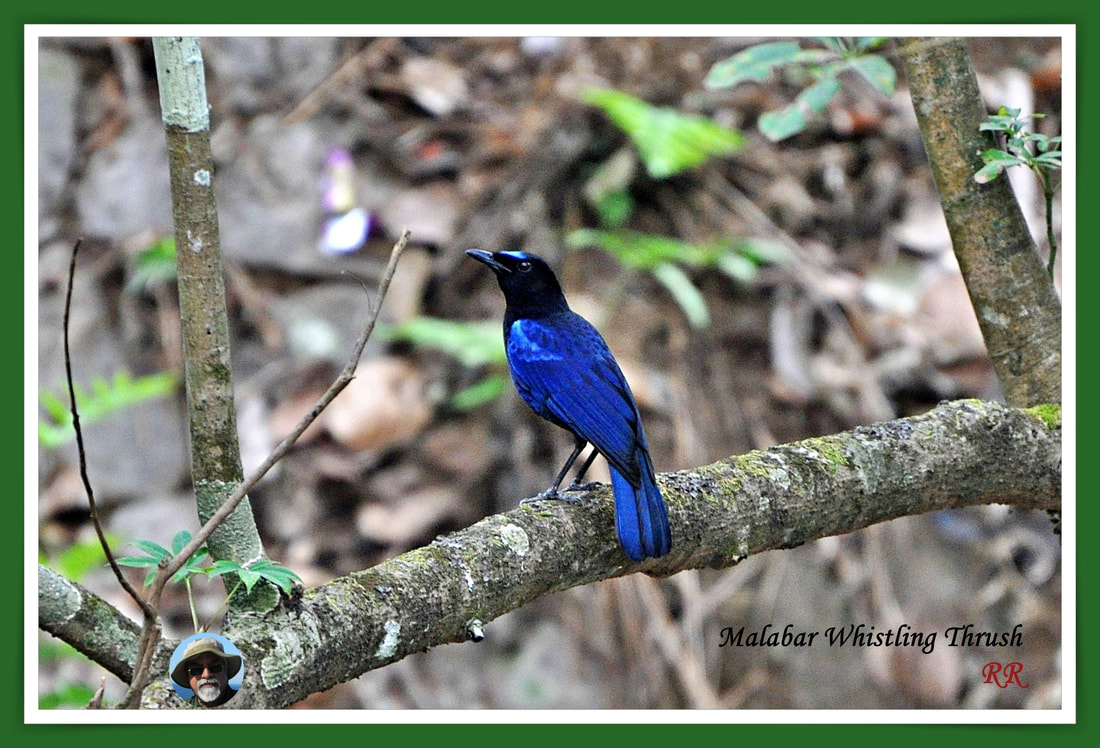|
One of the birds that kept me company in San Francsico was the red masked parakeet, also called Cherry Headed Conure. A flock of them would descend noisily on the tree opposite our son’s apartment near Lombard Street. It was a startling sight to see their colours in the morning sun.
These birds are native to Ecuador and Peru, but showed up in San Francisco's Telegraph Hill neighbourhood in the 1980s. From a population of only four birds, they began to settle and breed in the city in large numbers. They also attracted the attention of Mark Bittner an unemployed musician who was eking out his living as a caretaker in one of the Telegraph Hill’s historic, crumbling cottages. He was smitten with these colourful, noisy birds and started observing them closely. He published a book about these parrots in 2004 and in 2005 a film was made based on it, which catapulted Bittner and the parrots into popularity and the public eye. As people became more aware of these parrots, it also created some controversy. Since they were non-native species which can potentially threaten the native birds, conservationists argued that the flock should be removed. But people of San Francisco fought to keep the parrots intact, arguing that they were an important part of the city's culture and history. Ultimately, they prevailed, and the wild parrots of Telegraph Hill can be seen both in their home territory and all over the city as they scurry around for food. Parrots figure prominently in Sangam literature. They are vividly described in many poems. One of them even mentions about a parrot with red neck band! They reside in Kurinji thinai, (mountain and adjoining lands) where they come in droves to eat clusters of millet in the fields. The heroine and her friend who are sent by the family, chase the birds, using the rattles and other noisy implements. The parrots also provide an excuse for the heroine to meet the hero secretly, without the knowledge of the family. For instance, in Ainkurunuru (meaning five hundred short poems) which are generally dated from about the late 2nd-to-3rd-century-CE, Kapilar, the poet describes the how the parrots have given an opportunity for the man to meet the lover of his life. வெள்ள வரம்பின் ஊழி போகியும் கிள்ளை வாழிய பலவே, ஒள் இழை இரும்பல் கூந்தல் கொடிச்சி பெருந்தோள் காவல் காட்டியவ்வே. Translated as: May the parrots live longer even after trillions and trillions of eons! They are the reason that the lady from the mountains with long black hair and big shoulders, wearing glistening jewels came to watch over the grains. On the World Parrot Day let us hope that these colourful avian species live long and bing cheer int our lives! The parrots would like to hear from you...here!
16 Comments
Today is the Endemic Bird Day.
Endemic birds are those that are found only within a confined geographical area and it is always a moment to cherish when you spot one of them! Some years ago, George Mothi, my friend and a passionate bird lover took me on a day long birding sojourn in the Athirapalli region of Kerala. It was an unforgettable experience as we were lucky to see a wide range of avian beauties. As we were driving slowly in the forest, George stopped the car as he spotted some movement amongst the dense foliage. Looking closer, I could clearly see a bird, about the size of a crow, blackish with shiny patches of blue on the forehead and shoulders. Its glossy blue plumage with iridescent sheen glinted beautifully in the light. As I watched, the bird was looking for something in the grass. It suddenly halted and….whistled! I couldn’t believe my ears as the sound was so human-like. It is no surprise then that it is often referred as a “Whistling Schoolboy!” Of all the songbirds I have heard, Malabar Whistling Thrush which is endemic to peninsular India, mostly the Western Ghats, is the most mellifluous of them all! The great Salim Ali has commented: "Personally, I would choose as our most accomplished songster, the Greywinged Blackbird of the Himalayas. A number of its close relations, members of the thrush family including the Malabar Whistling Thrush and the Shama follow close on its heels”. The Kadar tribes in the Anaimalai hills believe that when an elder in their community dies, he or she is reborn as a Malabar Whistling Thrush. When they enter the forest and listen to its call they know that they are not alone. As always there is an interesting legend associated with this bird... One day Lord Krishna was wandering along the banks of a mountain stream when he came to a lovely spot with a small waterfall. Enchanted with the beautiful ambiance, he started playing his flute. As he was playing the music, he fell asleep and the flute slipped from his fingers. It was not a restful sleep and when he awoke, he was shocked to see a ragged urchin standing ankle-deep in the pool with the sacred flute held onto his lips. Krishna was furious. “Come here, boy!” he shouted, “How dare you steal my flute and disturb my sleep! Don’t you know who I am?” The urchin replied “I did not steal your flute, lord. Had that been my intention, I would not have waited for you to wake up. It was only my love for your music that made me touch your flute. You will teach me to play, will you not? I will be your disciple.” Krishna’s anger melted away, and he was filled with compassion for the boy. He laid his hand on the boy’s mouth, saying, “Forever try to copy the song of the gods, but never succeed.” Then he touched the boy’s clothes and said, “Let the raggedness and dust disappear, and only the beautiful colours of Krishna remain.” And the boy was turned into a bird with dark blue brilliant body which we now know as the Malabar Whistling Thrush. Its melodious call continues to reverberate among beautiful, forested valleys... Your lovely song Bouncing off the trees Straddling the wind Echoes in my heart still… Feel Free To Let The Whistling Schoolboy Know What You Think Of It... Here! |
Dr Raguram
Someone who keeps exploring beyond the boundaries of everyday life to savor and share those unforgettable moments.... Archives
May 2024
Categories |


 RSS Feed
RSS Feed